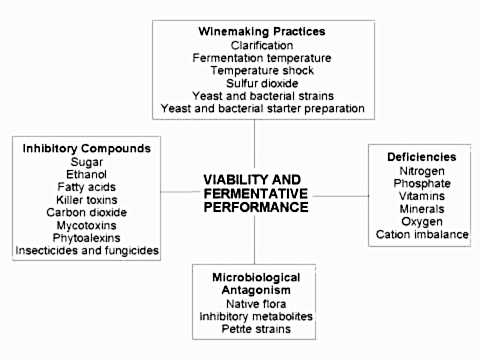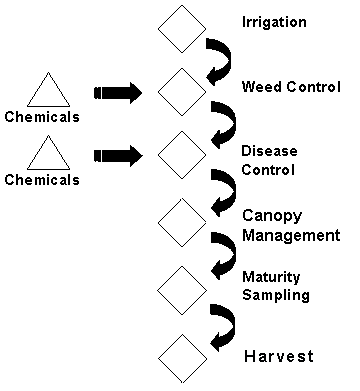Enology Notes
Enology Notes #115, August 17, 2006
To: Regional Wine Producers
From: Bruce Zoecklein, Head, Enology-Grape Chemistry Group, Virginia Tech
Subject: Conducting a Healthy Fermentation; Establishing a HACCP-Like Plan; Herbaceous Character in Red Wines, Continued; Virginia Tech Enology Service Lab
1. Conducting a Healthy Fermentation. Conducting a healthy fermentation is essential in premium wine production. The following figure lists some important features impacting viability and fermentation performance. For an additional review, see Enology Notes #105.

2. HACCP-Like Plans. Prior to the season, it seems appropriate to review the concept of HACCP, as outlined in Enology Notes #8, 22, 32, and 75. HACCP (Hazard Analysis and Critical Control Points system) is a means of assuring quality, through the identification and monitoring of critical control points from vine to glass.
The concept of HACCP was developed in the 1960s for the US space food program, and later adopted by the food industry as a means of minimizing the risk of contamination in food products.
HACCP-like plans are used by the wine industry to help integrate chemical, physical, microbiological, and sensory analyses, for quality and stylistic control.
HACCP-like plans for the grape and wine industry involve the following:
- Analysis of the dangers to product quality
- Identification and control of the critical steps in the production system
- Chemical, physical, microbiological, and/or sensory monitoring
- Verification
HACCP-like plans help to answer the following:
- Why each analysis is performed
- Where the analysis fits into the scheme of quality wine production
- When results are needed
- The specific range for each result
- What to do if the results are not within specifications
HACCP defines the production process, quality, and style indicators, and their recommended values. It identifies critical control points in the process using chemical, physical, microbiological, and sensory analyses. Measured values are compared with recommended values. An action plan is established to correct or modify any deficiencies, and action is taken. Results are assessed to determine if additional steps are needed.
Steps in Establishment of a HACCP-Like Plan.
- Create a flow diagram from vine to glass.
- Identify the critical control point at each step in the process.
- Establish critical limits for each analysis to be conducted.
- Develop a monitoring procedure for each critical control point.
- Establish a plan for corrective action whenever critical limits are exceeded.
- Establish a record system to document action steps taken.
- Develop a verification plan for all analyses utilized.
Step 1. Create a Flow Diagram.

Step 2. Identify the Critical Control Points at Each Step in the Process.
Each producer determines what he or she considers to be critical control points in the process for each wine. Below are examples of critical control points.

Step 3. Establish Critical Limits for Each Analysis to be Conducted.
For example, what is the acceptable fruit temperature range at crushing or pressing?
Step 4. Develop a Monitoring Procedure for Each Critical Control Point.
For example, if a certain sulfur dioxide level is required, do you have a means of accurately testing for sulfur dioxide?
Step 5. Establish a Plan for Corrective Action.
For example, if the fermentable nitrogen in the juice is too low, how and when will this deficiency be corrected?
Step 6. Establish a Record System to Document Action Steps Taken.
Adequate recordkeeping is essential to a functional HACCP-like plan and any quality control program.
Step 7. Develop a Verification Plan for All Analyses Utilized.
Do you know the precision or accuracy of your lab analyses? Are your sensory evaluation procedures designed to eliminate bias?
Viticultural HACCP-Like Plan.
A viticultural HACCP-like plan is important to help assure ultimate wine quality. A viticultural HACCP-like plan would involve the seven previously-listed steps. It defines the grape production process, identifies the critical control points, measured values are compared with recommended values, and an action plan for correcting deficiencies is established.

Critical control points for some vineyard operators may include:
- Soil and plant analysis
- Soil moisture
- Canopy density
- Day/night temperatures
- Rainfall
- Wind speed and direction
- Average time between bloom and harvest
- Number of canes
- Pruning weight
- Number of buds
- Cane weight (pruning weight/cane number)
- Clusters per vine
- Clusters per shoot
- Shoots per meter of row
- Cluster weight per vine
- Yield per vine (cluster number x cluster weight)
- Average cluster weight (yield/clusters per vine)
- Vine balance (yield/pruning weight)
- Vigor index (pruning weight/vine spacing)
- etc.
A sound viticultural HACCP-like plan would help answer the following questions:
- Do you have written product and handling specifications agreements with the winery you supply?
- Has the person responsible for spraying completed a farm chemical user training course?
- Can you prove that only approved chemicals are used, and that they are applied correctly?
- Are you certain that grape safety and quality aren’t compromised during transport to the winery?
- Can your grapes be traced from the winery back to a particular block in your vineyard?
- Can you provide records of all operations on your farm that affect the safety and quality of your grapes?
- Are staff members who do critical jobs trained properly?
HACCP Summary
- HACCP allows each winery to establish a quality control plan suitable to its own production practices and philosophy.
- Define the production process (viticultural, enological, storage, etc.), quality indicators, and their recommended values.
- Identify critical control points where analysis methods (including sensory) can monitor quality indicators.
- Establish and carry out analysis methods that will give quantitative or qualitative measures of quality indicators at each control point.
3. Herbaceous Character in Red Wines, Continued. As outlined in Enology Notes #114, red wines occasionally have excessive herbaceousness, resulting in a reduction in fruit intensity, and detrimentally impacting palate structure and texture.
This sensory feature is mainly derived from a group of nitrogen-containing compounds, pyrazines, which are present in green plant tissues, including grapes. One important methoxypyrazine, IBMP (2-methoxy-3-isobutylpyrazine), imparts a vegetal aroma at relatively low concentrations in the fruit, ranging from zero to 35 ng/L.
Several factors have confounded our understanding of methoxypyrazines, including their very low concentrations (and, therefore, difficulty in quantification) and their association with other compounds.
A concentration of 1 ng/L is 1 part per trillion. Allen (2006) put this in perspective in a presentation outlining the difficulty in monitoring methoxypyrazines: If the earth’s population is 6,493,359,729, then measuring IBMP would be roughly equivalent to measuring 154 earth populations.
An additional confounding factor is that herbaceousness can be caused by methoxypyrazine, certain monomeric phenols, and polyunsaturated fatty acid derivatives. These include compounds such as hexanal and hexenal, which we have measured in relatively high concentrations in some regional wines.
Some important issues regarding viticultural and enological parameters influencing herbaceousness were outlined in Enology Notes #114.
It is essential to have adequate ripeness and uniformity of ripeness. One universal problem has been the difference between berry sampling and the true maturity of the vineyard block. For issues relating to berry and cluster sampling, see Maturity Evaluation for Growers, online at www.vtwines.info. Click On-line Publications.
4. Virginia Tech Enology Service Lab. The Enology-Grape Chemistry Group at Virginia Tech has established a fee-based, full-service enology laboratory. This lab provides chemical, physical, microbiological, and sensory analysis, including standardized reagents.
The laboratory now conducts fining trials.
Details regarding this service are available at www.vtwines.info.
![]()
Subscription to Enology Notes. All past Enology Notes newsjournals are posted on the Enology-Grape Chemistry Group's web site at: http://www.vtwines.info/.
To be added to (or removed from) the Enology Notes listserve send an email message to with the word "ADD" or "REMOVE" in the subject line.
Dr. Bruce
Zoecklein
Professor and Enology Specialist Head Enology-Grape Chemistry Group
Department of Food Science and Technology, Virginia Tech
Blacksburg VA 24061
Enology-Grape Chemistry Group Web address: http://www.vtwines.info/
Phone: (540) 231-5325
Fax: (540) 231-9293
Cell phone: 540-998-9025
Email:
